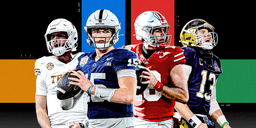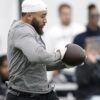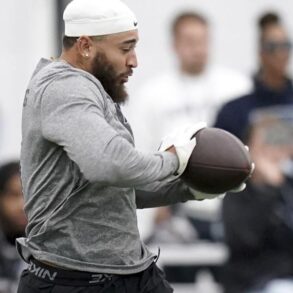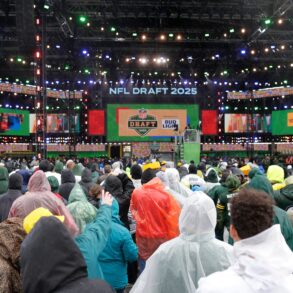In January 2019, I covered an Alabama-Clemson national championship game in Santa Clara, Calif. It was offputting to see those two fan bases walking around Silicon Valley. In January 2022, I was in freezing-cold Indianapolis for another game between two teams from the Deep South, Georgia and Alabama. Also weird. Now, three years later, I’m going to the SEC’s unofficial hub, Atlanta, to see a Notre Dame–Ohio State game.
Advertisement
It should be a fun sociology experiment.
Will we look back on the era of SEC dominance in a similar way to the steroid era of MLB? Of course the records and wins will stand, but there was rampant cheating by many (mainly SEC) teams. Now that the field has been somewhat leveled by NIL and transfers, we see the advantage of the SEC bagman has disappeared. — Tim K.
I’m going to push back on this narrative, for two reasons.
One, it’s entirely anecdotal whether the SEC “cheats” more than other schools/conferences. Ole Miss under Hugh Freeze, LSU under Les Miles and Tennessee under Jeremy Pruitt all got busted. But there’s a long list of non-SEC programs — Ohio State (Tatoogate), Michigan (Harbaugh), USC (Reggie Bush), Miami (Nevin Shapiro), North Carolina (John Blake/agents), Arizona State (Herm Edwards) and others — that have been sanctioned for major NCAA violations more recently than Alabama (2009) or Georgia (1997).
Secondly, the amounts of money involved when people did get caught were not remotely on par with what we’re seeing with name, image and likeness. The Tennessee/Pruitt recruiting scandal from a few years ago involved $60,000 in impermissible benefits spread across 39 athletes or their families. Today, $60,000 wouldn’t be enough to land you even one high-end player.
But most of all, even if every single SEC school was cheating, it wouldn’t change the fact the conference had more top-end high school talent in its footprint than any of the other former Power 5 leagues. And that gave them a considerable advantage in the traditional recruiting model.
But no question, NIL and the portal have chipped away at that advantage. In the old system, everyone was offering pretty much the same thing to all players: a full-ride college education. With the compensation being mostly equal, the top players coalesced around a small handful of schools (Alabama, Ohio State, etc.) with the most proven track record of winning championships and putting guys in the NFL. Now, in a free market, a wider net of schools from other parts of the country can get in the game, either by outbidding their counterparts (see: Miami) or being smarter at how they deploy their money (see: Notre Dame).
Advertisement
Specifically in the case of Alabama, Georgia and LSU, their past success might have hurt them in this new marketplace. Their fans/donors haven’t been as desperate as the folks at long-suffering programs like Tennessee and Ole Miss. That’s why Alabama athletic director Greg Byrne effectively begged for NIL donations last month. Or why Brian Kelly lamented in the spring that LSU was “not in the market of buying players.” Or why Kirby Smart joked of Phil Knight, “I wish I could get some of that NIL money he’s giving Dan Lanning.”
Alabama fans,
Over the past few years, there have been drastic changes in college athletics. We have been careful during this transitional period to protect our position at the top of college athletics while being mindful to listen, engage and learn from our generous…— Greg Byrne (@Greg_Byrne) December 18, 2024
I now realize I never answered the actual question. No, I do not look at the 2006-2022 era of SEC dominance like the MLB steroids era. How could I? I’m on record saying Michigan’s 2023 national championship is not tainted because of Connor Stalions’ scheme that got stopped midseason, and that involved actual straightforward, documented cheating.
Miami just committed an all-time NIL outlay (plus its 2025 season) to Carson Beck, and its fan base seems stoked. Georgia just lost that player, and its fan base seems quite content. Is either/both side(s) being a little too optimistic about what the future holds? — Jessica S.
It’s an unusual situation. Georgia and Beck had been operating all year under the assumption the quarterback would turn pro after this season — which he initially announced as his plan. But then he got hurt. And didn’t have a great season. His NFL stock was dropping. So it makes sense he’d opt to return for another year of college.
But it wasn’t realistic Georgia would keep a spot warm for him that whole time. Or that it would suddenly come up with $3 million for him with little notice. And of course, we don’t know whether Beck even wanted to return to Athens even if the money was the same. Still, I don’t know why any Dawgs fan who watched Gunner Stockton against Texas and Notre Dame would be thinking, “Yep, definite upgrade from Carson Beck.” Something tells me Georgia’s 2025 QB is not yet on the roster.
As for Miami — kind of the same thing. I don’t know anyone who watched Emory Williams in his two starts as a freshman last year or in the second half of the bowl game against Iowa State and felt completely confident in him as Cam Ward’s replacement. The Canes went out and got Beck in the hope he can replicate his first season as Georgia’s starter in 2023. If he can’t, then that reported $3 million-plus figure is going to get thrown back in Miami’s face. But this isn’t the NFL. There’s no salary-cap hit. Because there’s no salary cap.
Advertisement
Will Howard doesn’t seem to get as much credit for the Buckeyes’ success as his statistics suggest he should. Will a championship change this perspective? I’m curious to see how NFL scouts evaluate his potential at the next level. — Charlie C.
Normally the QB gets too much credit, but on a team with Jeremiah Smith, Emeka Egbuka, TreVeyon Henderson, Quinshon Judkins, Jack Sawyer … you can see how that might not happen.
Howard, who’s completing 72.6 percent of his passes for 3,779 yards, 33 TDs and 10 interceptions, is third nationally in passing efficiency (173.7), and he was better than that in Ohio State’s first two CFP wins over Tennessee (188.7) and Oregon (206.5). He was less efficient against Texas (150.2), but in the fourth quarter, with the score tied 14-14, he led the Buckeyes on an 88-yard touchdown drive in which he picked up two first downs through the air and another, on fourth-and-2, on his own 18-yard-run. I thought he played well, despite some mistakes like his interception when he tried to force one to Smith.
But there’s some residual skepticism around Howard stemming from a few of his low moments during Ohio State’s regular season: Letting the clock run out against Oregon, throwing a pick six at Penn State that put his team behind 10-0 at the time (he subsequently threw two touchdowns in the win) and, of course, the Michigan game. Those happened to occur in the three most-watched games of the Buckeyes’ regular season.
All in all, Ohio State should feel pretty good about having Howard lead them against that great Notre Dame defense. He’s probably not going to be an NFL starter — as he’s not an athletic wonder like some previous Buckeyes QBs — but could he be a long-term backup? This game might help determine that.
Is this a once-in-a-decade chance for Notre Dame to be in natty, or is this the start of a return back to the upper echelons of college football for the Irish (assuming Marcus Freeman stays)? Although ND was good between 2012-2021, no ND team has looked this competitive with major programs. — Greg E.
I don’t think it’s realistic to expect any program to make frequent appearances in the national championship game in the 12-team College Football Playoff. It’s going to be really hard! Not only do you have to successfully build and rebuild your roster year after year, but you have to avoid bad luck once you reach the Playoff. You could be Oregon and get a bad draw. Or you could be Georgia and lose your starting quarterback to injury right before the Playoff starts.
But there’s no reason Notre Dame can’t regularly get into the CFP and win games. For all the reasons I gave in the “SEC cheats” answer, the landscape of the sport has tilted in the school’s favor. I suppose the broader question for Irish fans is: What constitutes a successful season? A year ago, they might have said just making the Playoff, but Freeman has upped the expectations. Is it win one game? Reach the semifinals?
It might go hand in hand with …
For college basketball, it seems that making it to the Final Four is seen as a major accomplishment. You always hear about programs, or even coaches, getting recognized for how many Final Fours they have reached. Now that we are in an extended Playoff format for college football, do you think that making it to the Final Four will have the same recognition as basketball? — Tom D.
Probably not, because the Final Four is an event, played back-to-back on the same floor over three days, not one semifinal in Dallas, the other in Miami and a championship game a week later in Atlanta.
Advertisement
Also, it’s trademarked.
But perhaps “semifinal appearances” will become a thing?
There were a lot of considerations for the schedule of the 12-team Playoff. After going through it for a year, what are some of your takeaways? You’ve advocated for moving the entire season up. Do you still think that is necessary? — Eric A.
Overall, the Playoff has been so enjoyable I’m reticent to nitpick it. But we can all agree: It’s been going on for a loooong time. I was reminded this week of a story I wrote after the teams were announced in which I ranked the most to least likely national title matchups. (Ohio State-Notre Dame was No. 5, thank you very much.) That article is dated Dec. 9! Monday’s game will take place exactly six weeks later.
As for the timing of the games themselves — it’s been about as I expected going in. The first-round going against the NFL was frankly unavoidable. The NFL was kind of a jerk about it, frankly, purposely putting better games on that Saturday than it has in the past. Hopefully, it will back down next year. The New Year’s quarterfinals were awesome and highly watched — ranging from 13.9 million for Penn State-Boise State to 21.1 million for Ohio State-Oregon.
But the Jan. 9 and 10 semifinal bowls felt weird. I got to Dallas on a regular Wednesday workday and went to Ohio State’s hotel, where I watched the Buckeyes arrive from the airport to flashing lights, cheerleaders and a line of fans in the hotel lobby. It was purportedly a bowl game, but the game was less than two days later. And though that one did 20.6 million viewers, 17.8 million for the Thursday night Orange Bowl made it 21st out of 26 semis all time. Despite being a great game. Those weeknight time slots are less than ideal, but the NFL has the entire wild-card weekend blocked off.
It would not be easy to get everyone to move the regular season up a week, but it would have a lot of benefits. It gives you two weekends on the front end with no NFL competition and moves the first round up to what is currently Army-Navy week, the last Saturday that the NFL is prohibited from competing against college football. The next week’s quarterfinals would likely move to campuses, allowing the top-four seeds to host a Playoff game. And the semis would move back to New Year’s Day where they belong.
Most of all, if the Playoff ends in early January, guys might not feel forced to choose between the portal and the Playoff.
Advertisement
Which five programs (in order) would you say are the most accomplished this century, and how would an Ohio State championship next week affect their ranking? — Thomas K.
Great question. It wouldn’t affect the order for me, because I already have Ohio State No. 2 behind obvious No. 1 Alabama. Though LSU has three national titles to Ohio State’s current two, the Buckeyes have the best winning percentage in the sport (.836) and nine BCS championship/CFP berths to LSU’s four. In fact, LSU’s high highs and low lows make it hard to justify putting it even No. 3.
My order would be:
- Alabama (six national titles, 11 BCS/CFP, .767)
- Ohio State (two national titles, nine BCS/CFP, .836)
- Oklahoma (one national title, eight BCS/CFP, .791)
- LSU (three national titles, four BCS/CFP, .746)
- Georgia (two national titles, four CFP, .778)
Georgia narrowly edges Clemson (two national titles, seven CFP, .741) mostly because the Dawgs had a much better first decade than the Tigers.
After Penn State’s loss in the Orange Bowl, the national media was split down the middle. Some wrote that fans should feel more optimistic than ever, while others said James Franklin missed his one chance at a title. So, which is it? — Tom
I was definitely in the optimistic camp. And that was before this week’s news that Penn State is getting the band back together — star running backs Nick Singleton and Kaytron Allen announced they’re returning in 2025, as did defensive end Dani Dennis-Sutton, who should become the new face of the defense with Abdul Carter off to the NFL. Quarterback Drew Allar, defensive tackle Zane Durant and safety Zakee Wheatley had previously announced their returns as well.
The only bad news in State College was defensive coordinator Tom Allen’s departure for Clemson after just one season, but Penn State’s run of top-10 defenses spans three coordinators (Brent Pry, Manny Diaz and Allen).
I get it, Franklin still hasn’t beaten a top-five opponent since 2016 and has lost eight straight years to Ohio State. He’s not earned much benefit of the doubt. But Penn State did win 13 games this season, including two against CFP opponents, which is hardly a small feat. And the offense got more creative and more explosive under first-year coordinator Andy Kotelnicki.
I do realize there’s a split camp when it comes to Allar, whose detractors got more fuel with his interception that ultimately cost Penn State the game against Notre Dame. He’s not the problem. He completed 66.5 percent of his passes for 3,327 yards, 24 TDs and eight INTs despite having a tight end as his only dependable target. Franklin is only going to win a national championship if he can deliver Allar some functional receivers.
Advertisement
So the CFP proved that defense wins championships, right? — Melissa B.
It’s more that the past couple of seasons proved defenses can still win championships. After a brief period when it seemed like those days might be over.
We had a run of national champions that all had ridiculous offenses led by highly efficient quarterbacks — Clemson with Deshaun Watson (2016) and Trevor Lawrence (2018), Alabama with Tua Tagovailoa (2017, albeit for one half) and Mac Jones (2020), and most notably, that 2019 LSU team with Joe Burrow. Nick Saban himself said in 2020, “Good defense doesn’t beat good offense anymore.”
Then Georgia happened. The 2021 Dawgs fielded a historically dominant defense and, after flailing in the teams’ first meeting, shut down Bryce Young in the national title game against Alabama. The 2022 team humbled an explosive TCU squad. And though last year’s Michigan team did have a first-round quarterback, J.J. McCarthy, its identity was its defense, which shut down Michael Penix Jr.
The 2024 season has swung even more to the side of defenses, as the four semifinal teams (Ohio State, Texas, Notre Dame and Penn State) rank in the top seven nationally in yards per play allowed. In 2022, the two semifinal scores were TCU 51, Michigan 45 and Georgia 42, Ohio State 41. This year: Notre Dame 27, Penn State 24 and Ohio State 28, Texas 14.
Though those defenses were exceptional, facing Howard, Allar, Riley Leonard and Quinn Ewers is not the same murderer’s row as that list of first-rounders from 2016 to 2020. And it’s not just the CFP teams. A QB broke the FBS pass-efficiency record in every season but one from 2016 to 2023, topping out with Jayden Daniels last season (208.0). This season’s leader, Jaxson Dart (180.7), was nearly 30 points lower.
So let’s see what happens next season. Maybe defenses continue to dominate. Or perhaps someone new (Arch Manning?) one-ups Daniels.

GO DEEPER
CFP quarterback confidential: How good are the final four QBs?
Can we get an official Notre Dame-Ohio State prediction? — Robert K.
You can. But only for recreational purposes.
Ohio State 27, Notre Dame 16
(Photo of Nick Saban and Alabama: Scott Cunningham / Getty Images)
This post was originally published on this site be sure to check out more of their content.






